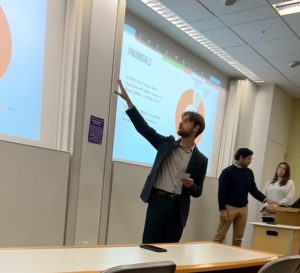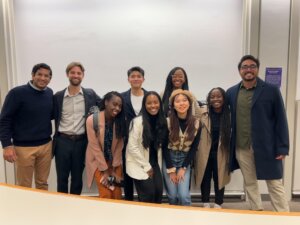In this edition of Fridays from the Frontline, Brian Ward, a third-year MBA/MPA dual-degree candidate at the NYU Stern School of Business and Wagner Graduate School of Public Service, shares how NYU’s student-led impact fund helped him chart a course to make an impact.
Learning To Drive System-Wide Change Through NYU’s Student-led Impact Investment Fund
By Brian Ward, NYU MBA/MPA ’24
Our world faces challenges that media headlines frequently characterize as insurmountable – climate change, economic inequality, demographic inversion, and over 100 million refugees and people displaced from their homes.
For many prospective graduate students, these are the central issues of our lifetimes – the problems that we hope to devote our careers to solving. If this sounds like you, you might have also asked the question, through which career path can I maximize my impact? This was the guiding question that I entered graduate school with as a dual MBA/MPA candidate at NYU’s Stern School of Business and the Wagner Graduate School of Public Service.
I wish I could tell you that I unearthed one simple career trajectory to achieve system-level social impact. Instead, my coursework and informational interviews with professionals in the social finance, global business, and policy fields revealed a social impact landscape that is amorphous, decentralized, and relationship-based. When it comes to system-level change, though, one theme remains constant: innovation – new business models, technologies, products, and services that make it possible for our society to grow (or de-grow) sustainably. I learned that if you want to have a say in which innovations are brought to life, look no further than a career as an impact investor.
That’s what drew me to apply for NYU’s student-led Impact Investment Fund (NIIF), a year-long experiential learning course that brings together graduate and undergraduate business and policy students, including students from NYU – Abu Dhabi! Unique from other student-led impact funds that are solely composed of business students, NIIF’s multidisciplinary nature fosters collaboration between students with diverse experiences and professional backgrounds. Perhaps more importantly, NIIF students share a common passion for solving social problems, and many alumni pursue careers in the impact space upon graduation. The NYU Impact Investment Alumni Club (NIIAC) sustains the relationships forged in NIIF, and connects participants to a wider network of practitioners.
Through taking this course, I have started to see a clear path forward on how to drive system-wide change, and engage with practitioners taking on these roles.
Searching for Social Impact at Scale
How did I end up participating in NIIF? Before coming to NYU, I was a Senior Consultant within Deloitte’s State & Local Government Practice. Though I felt fulfilled, I wanted to learn more about innovative strategies that governments, private actors, and nonprofit organizations can employ to fortify the social safety net and create wealth that is beneficial to communities.
With this mindset, I came to Stern and Wagner for a dual MBA/MPA and soon discovered the relatively nascent field of Social Impact Investing, which is founded on the premise that businesses can and should design products and services that create environmental, social and financial returns. NIIF has been a fantastic opportunity to learn about impact funds, network with professionals in the field, and gain the experience of working on a deal.
The NIIF Student Experience
NIIF invests “patient” capital into social enterprises, expecting long-term social and financial returns in the sectors of financial inclusion, environment, healthcare and aging, education, and food systems. Since its inception, NIIF has made four investments totaling $110,000 in the education and environment sectors. My class is working on the fifth investment, which we’ll make later this spring.
Sourcing, Due Diligence, and Pitching
Each year, NIIF deal teams source potential companies in their sector of focus, conduct due diligence, and present selected investment opportunities to fellow classmates and course faculty. Teams generate an investment thesis at the beginning of the course, articulating a theory of change and narrowing the scope of potential investments. Due diligence activities not only assess the financial viability of the social enterprise, but also the viability and scale of the social or environmental intervention. Teams dive into the weeds, collecting financial, legal, and operational information from potential investees, applying detailed rubrics to evaluate risk, and validating projections and claims when possible. NIIF partners with industry professionals to align our investment process with real-world practices. Teams conducting legal diligence and drafting term sheets are supported by Perry Teicher, Social Finance Counsel at Orrick, Herrington & Sutcliffe LLP, who is providing pro bono services and guidance.

Following an initial pitch day and a second round of due diligence presentations, the field has narrowed to two potential recipients of this year’s $30,000 investment, in either medical devices for women’s health or sustainable energy. Stay tuned for the results of this good-natured showdown later this spring!
Learning the Language and Mindset of a Social Impact Financier
Reflecting on my NIIF experience last semester, I was surprised by the generosity of practitioners in the space, many of whom were excited to welcome newcomers to the field. Yes, at times sourcing felt like shouting into the void, and many outreach emails went unanswered. With persistence, though, I found “connectors” who were passionate about sharing their knowledge and networks. The most valuable takeaway from NIIF has been engaging with these social innovators, and learning the language of social impact finance. Social impact jargon can be mystifying, in part because every organization has its own dialect. Over time, listening to professionals connect the dots in different ways, the word soup became more intelligible. Now, as I recruit for full-time roles this spring, I have greater confidence in my ability to communicate theories of social innovation and change through a cross-sector framework. Beyond terminology, I’ve learned to think like an impact investor by going through each step of the deal process and working through challenges along the way.









